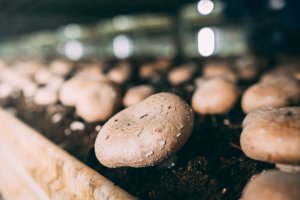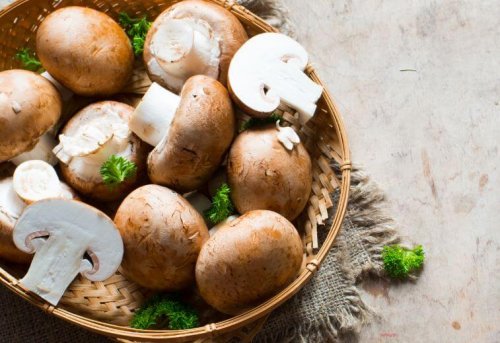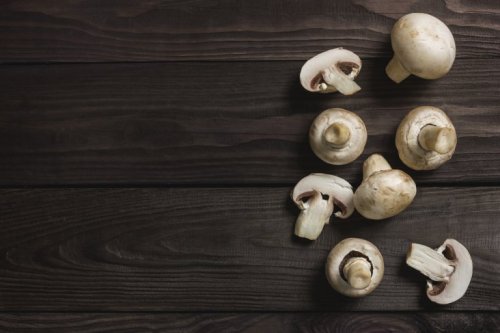Growing Mushrooms at Home

Believe it or not, growing mushrooms at home is quite easy. The best part is that you can pick them and eat them, and they’ll always grow back. However, to start, it’ll help to review a few things.
First, remember that mushrooms (Agaricus bisporus) are a type of edible fungus. In fact, both the stem and the hat are used. Fungus is different than plants because it doesn’t have a root, stem or leaves. It doesn’t contain chlorophyll, so it instead feeds on outside matter.
Mushrooms also don’t have any seeds. Instead, they grow from spores. Once spores find the right humidity conditions, they can germinate and produce hyphae. Then, these branch out and form a mass called mycelium.
The Advantages of Growing Mushrooms at Home

There are countless advantages to growing mushrooms at home. Here are just a few:
- You’ll get the satisfaction of producing your own food at home.
- It’s an excellent learning opportunity for children since it gives them the experience of watching the mushrooms grow.
- It’s an effective production. From just one spore, you can get an entire crop.
- Harvesting mushrooms is easy, so its value increases when compared to buying them in the supermarket or grocery store.
- You’ll have to security of knowing that you’re eating something that hasn’t been processed and that is genuinely natural.
Read: Ten Plants You Can Easily Grow In Your Garden
How to Grow Mushrooms at Home
To grow mushrooms at home, you have to make sure you have the space for it. If you have room in your yard, you can use an area to cultivate the mushrooms.
On the other hand, if you live in an apartment, it’s best to choose an elongated flowerpot and put it in a dark place. Remember, since mushrooms are fungus, they don’t need sunlight.
Growing mushrooms is easier than it seems and you can continue to cultivate them in the same soil until it no longer has any substrate.
Materials
- Straw
- Water
- Compost
- Grain mycelium (you can also buy mushroom bulbs already pre-cultivated)
- A box (preferably made of polystyrene since it doesn’t rot or decompose, and it helps contain humidity and temperature). Make sure to also get a lid for this box.
Steps
- Before starting, we recommend boiling the straw. You should do this to eliminate any germs and any fungi that might be on it.
- Mix the compose with the straw while you moisten it a bit. If you’d like, you can add coffee, because it will nourish to compost and favor the mushrooms’ growth and development.
- Place this mixture in the box. Keep in mind that the more substrate there is, the more mushrooms you’ll be able to produce, so add as much as you can.
- Spread the grain mycelium evenly and cover it with some wet mulch. Add some water.
- Cover the box with a lid to prevent any sunlight from entering. Then, leave it covered for 5 to 8 days. It’s important to keep the box moist during this time until you see a whitish blanket on the soil. This means that the mycelia have colonized the soil.
- Now, make another lid for the box that will give the mushrooms some space to grow. Make a hole in the center of the lid to let in a little light, but always indirectly. Cover this lid with a transparent film to prevent losing moisture or heat.
- It’s important to keep the humidity at 80%, but no more. If you’d like, you can water the inside of the lid instead of directly water the mushrooms. Once the water has evaporated, it will be time to water it again.
- You’ll get your first harvest in about 20 days, when the mushroom tops have a diameter between 2-3 inches.
- Once the area under the tops are pink, remove them from the soil. To do this, lightly twist the body until you can pull it from the soil.
- If you’ve followed the steps correctly, you should have a new crop every week. Now, you can enjoy your own organic mushrooms and prepare your favorite recipes!
Discover: Chicken Au Gratin with Mushrooms Recipe
Some Recommendations

As you can see, growing mushrooms is easy. However, it requires a little patience and dedication. Keep in mind the following tips when preparing your crop:
- Make sure that the space you choose to grow your crops has good ventilation. That way, you’ll prevent any bad smells or other issues.
- Use a nutritious compost, since that’s where the mushrooms will get their nutrients to help them grow.
- The optimum temperature should be between 71-80 degrees Fahrenheit. If the temperature is any higher than that, it will damage your crops. If the temperature exceeds 95 degrees, you should stop growing them.
- You can use a diffuser to irrigate your crops.
- Wash your tools before and after using them. That way, you’ll prevent contaminating your medium.
- A dark room or garage are ideal places to grow mushrooms.
This text is provided for informational purposes only and does not replace consultation with a professional. If in doubt, consult your specialist.








